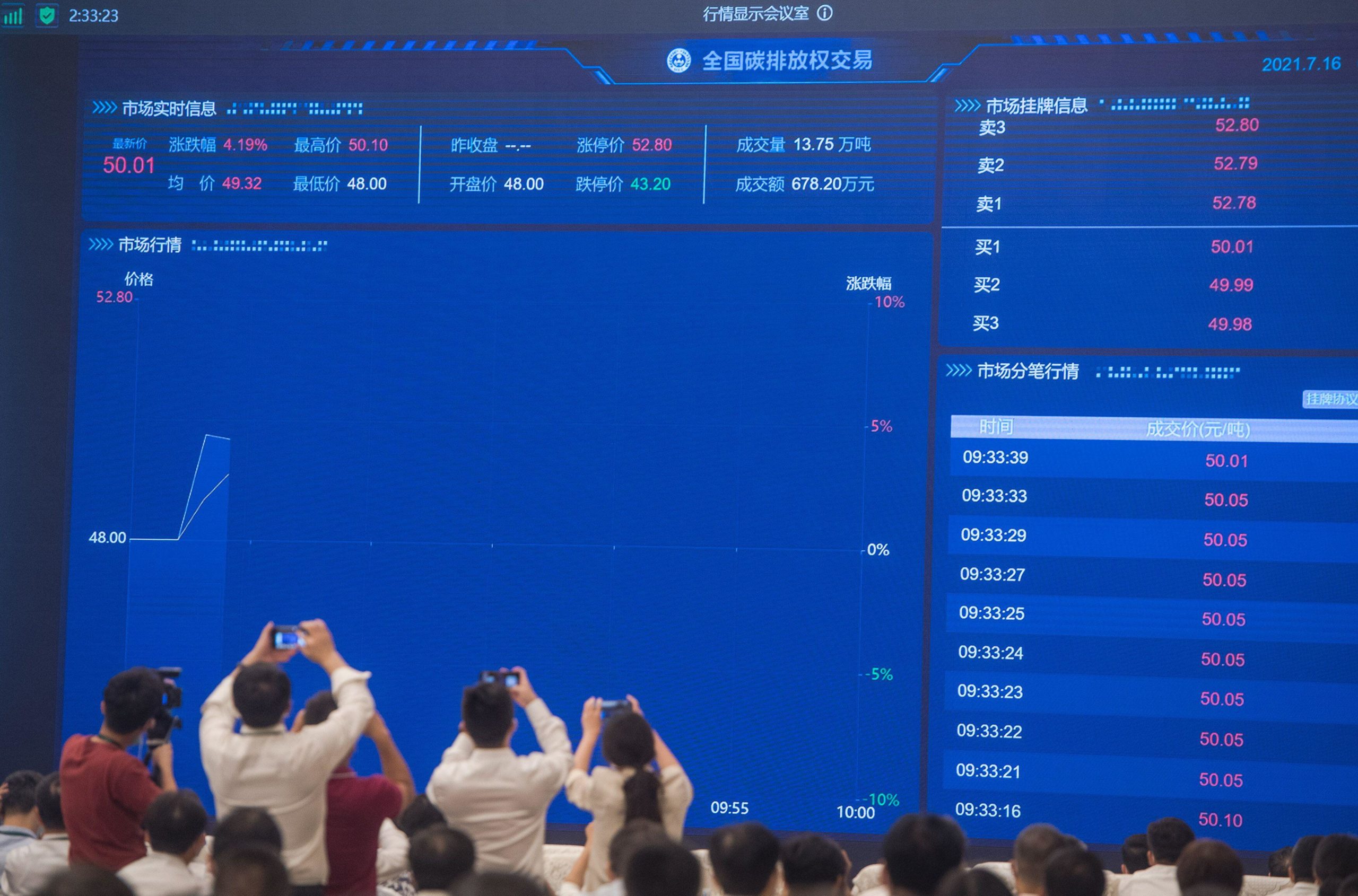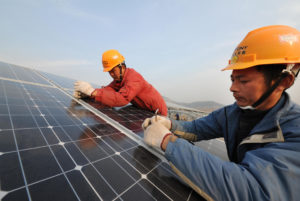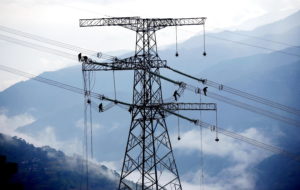On 16 July, trading started on China’s national emissions trading system (ETS). This is the first nationwide explicit price on carbon, for now covering companies in the power generation sector.
With overarching regulation for the national ETS having entered force in February, and rules for the registry, trading and clearing of allowances released in May, China now has in place the key building blocks for trading in carbon allowances between large emitters. In its first compliance cycle (for emissions from 2019 and 2020), the ETS covers 2,162 power companies across the country, responsible for a total of over 4 billion tonnes of CO2 emissions annually.
The carbon price had been one of the most conjectured upon features of the new carbon market, with predictions ranging from under 38 yuan/tonne (US$5.85/tonne) to 49/tonne. On the opening day, trading started at 48/tonne and closed at 52.8/tonne, hitting the daily 10% upper limit on price variation. In the first two weeks of trading, about 6 million tonnes of allowances were traded at a value of about 300 million yuan. As of 5 August, prices were trading between 53–59/tonne.
This suggests that the prices are within the range of expectations of key stakeholders, including those working in the power generation sector. Trades on the opening day were pre-arranged to coincide with the opening ceremony at the Shanghai Environment and Energy Exchange and sister events in Beijing and Wuhan, prompting some observers to caution against putting too much weight on them as a sign of prices within the first compliance period overall. If oversupply becomes evident in the coming months, it is possible prices may drop towards the end of the year.
The launch of trading is undoubtedly a major step towards the goal of realising the intended role of carbon pricing – reducing China’s emissions. As with most carbon pricing systems, however, it will necessarily be a learning-by-doing process. Some of the potential challenges that the system will face, now that trading has been initiated, include:
- Credibility of emissions data
In late June, just as authorities were preparing to launch trading, significant concerns were raised around the integrity of the emissions data of some market participants. This reinforced the importance of strengthening the rules and penalties around monitoring, reporting and verification (MRV) of emissions, to ensure that the data underpinning the market operation is credible.
- Absolute cap
Transitioning from carbon intensity-based allocation of allowances to an absolute cap on emissions is increasingly recognised as an important step to improve the effectiveness of the ETS. This is in terms of incentivising transformational change both in the power sector and in other industrial sectors that will be added into the system in the coming years.
- Liquidity
Market players beyond the compliance companies, such as institutional investors, are looking forward to having access to the market. In addition, regulators may explore the potential for providing for additional and varied trading products in order to facilitate liquidity.
- Policy coordination
It is important that there is coherence with other relevant policies, such as power market reform, trading of energy consumption rights, and trading of renewable energy quotas. If carbon pricing is to play its intended role in cost effectively driving down emissions, it is crucial that other policies do not negate its effect, but are coordinated to be complementary.
- Transition from pilots to national ETS
The roadmap and approach for the next steps in transitioning from regional pilots to a fully functioning national ETS needs concrete milestones.
From an emissions-reduction perspective, it is important to be aware of what the system is and is not able to achieve at this stage. Because allocation of allowances under the ETS is based on the carbon intensity of electricity production, rather than the overall emissions of a business, the key incentive created is for a shift from less efficient operators to more efficient ones. It has been pointed out that this misses the opportunity to incentivise shifts away from coal power to renewables.
Even so, the shift from less efficient to more efficient coal operators does provide the potential for some significant emission reductions in the short term. The central government began introducing a deliberate policy of “Promoting large and closing small” coal-fired power plants during the 11th Five Year Plan (2006–2010). While some efficiencies were achieved, about 60% of China’s operating coal power units are still inefficient sub-critical ones, accounting for about 44% of total coal power generation capacity, according to Global Energy Monitor’s Global Coal Plant Tracker.
If all of the electricity currently produced by power generation units under 300MW capacity were instead generated by 600MW units, it would cause on average about 19% less CO2 emissions. If it were generated by 1000MW units, emissions could be reduced by about 26% on average. In an economy where power generation causes over 5 gigatonnes of CO2 annually, these potential reductions are not insubstantial. Of course, while these reductions are technically possible on paper, there are real-world obstacles to achieving them, including limits to inter-connectivity within the power grid, and guaranteed operating hours to smaller units.
An additional obstacle to fully realising the emissions reduction potential from the ETS is that the allocation of free allowances will apply differently to small and large power generation units. In the EU, power generation received free allocation based on one single, sector-wide benchmark. At the start of China’s national ETS, units 300MW and below face a benchmark for free allocation 10% more generous than those with larger capacity (measured in terms of emissions intensity of production). While this could potentially blunt some of the effect of the ETS in encouraging a shift away from inefficient units, there are regional distribution motivations for this approach. The smaller units are not spread evenly across China, but are rather concentrated in certain parts of the country. Provinces such as Heilongjiang (in the northeast) and Yunnan (in the southwest) see half of their generation capacity concentrated in such small units, meaning that when they go offline it will have a bigger impact on these province’s power supply as well as on local economies.
The local economic challenge comes in to focus in towns like Qiqihar in Heilongjiang, where two thirds of local generation capacity is made up of 200MW subcritical units that were installed in the 1980s. Qiqihar is an old industrial town northwest of Harbin, and it has not received the same level of investment in updating power generation and transmission infrastructure as other parts of the country. The closest ultra-high voltage (UHV) power line ends about 400km away in Inner Mongolia. More support for coal-power towns like Qiqihar is needed in order mitigate the risk of the ETS bringing shocks to local economies.

The good news is that the ETS is riding a wave of enthusiasm and political momentum this year, which may lead to some ambitious reforms to enhance its effectiveness within the 14th Five Year Plan period (2021–2025). Experts working on the ETS have been actively exploring changes to the design such as: an absolute cap on the emissions of covered businesses, rather than a cap on the carbon intensity of power production; the inclusion of industrial sectors such as steel, aluminium, cement and chemical production; development of stronger legal enforcement via State Council regulation; and improvement in the oversight of monitoring and reporting of emissions. In addition, the discussion around a “just transition” is gathering pace in China, with options being explored for financing channels to ameliorate the inevitable economic effects on coal-dependent communities. If these opportunities can be realised within the next few years, carbon pricing can be expected to start playing the decisive role in reducing emissions that it is intended to achieve.









